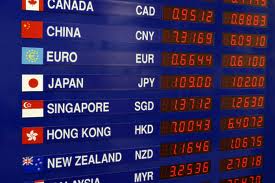Factors affecting the strength of exchange rate of a currency
 A vast amount of literature reviewed recognize following factors as determinants of the strengths of currency exchange rate:
A vast amount of literature reviewed recognize following factors as determinants of the strengths of currency exchange rate:
Inflation
If the inflation rate is low in a country the value of its currency and its purchasing power towards other currencies rises, meaning its currency becomes stronger. Alternatively, countries with high inflation rate experience their currency depreciating against the currency of countries they trade with.
The relationship between inflation and the exchange rate is that fixed interest regime can be practiced by countries with the aim of controlling the inflation rate. Initially it was done on the basis of Bretton Woods agreement before it was annulled in early 1970’s, which allowed other countries to fix their currencies against US dollars. Although fixed interest rate regime does help governments to control their inflation it has negative sides as well in the forms of vulnerability to the speculation and inability of undertaking domestic monetary policy.
Interest rates
Interest rates and exchange rates are correlated. Higher interest rates cause the exchange rates to increase, because higher interest rates would generate more profit for lenders, at the same time, attracting foreign capital. Conversely, if interest rate in a country is lower, exchange rates tend to be lower as well.
Speculation
According to Economicshelp (online, 2010), a fixed exchange rate can be a victim of speculation if the following three conditions apply:
- The currency is at the wrong market value
- .The Government doesn’t have sufficient reserves to protect the currency.
- People have no Confidence in the government intervention.
Relative strength of other currencies
For obvious reasons the relative strength of other currencies are going to affect the exchange rate of a currency of a country. If the strength of any other country currency increases for various range of reasons the exchange rate of currency of the trading country decreases and vice versa.
Balance of trade
Any changes in exchange rates are going to have reflections on balance of trade of that country. Strengthening of currency exchange rate will result in reduced import prices and increased export prices.
Political factors
Political factors also play an important role in the strength of currency exchange rate due to the fact that foreign investors seek politically and economically stable countries to make investments. If any political chaos or turmoil takes place in a country it will most likely result in a loss of confidence in a currency of that country, and outflow of capital from that currency to more stable currencies.
Capital mobility
Etwaroo et al (2008, p.11) classify capital headings under three main categories: foreign direct investment, external debt, and portfolio investment, and identify each of them as a major determinant of exchange rate value.
Factors affecting the choice of currency regime in China are divided into three groups by Etarwoo et al (2008, pp.11-17):
A) General factors:
- Export led growth strategy
- Capital mobility
- Financial sector development
- Dollarization
- Rate of inflation
- Political factors
- Regional exchange rate arrangements
B) The dollar-peg system:
- Export led growth strategy
- Capital mobility
- Financial sector development
- Dollarization
- Rate of inflation
- Political factors
C) The basket-peg system:
- Political factors
- Achieving monetary policy independence
- Developing the domestic financial sector
- Preserving trade competitiveness
- Growing current surpluses and an reserve accumulation creates an undervalued currency
- A move towards greater exchange rate flexibility
- Degree of international financial integration and trade pattern
- The Role of IMF
References
- Currency Speculation and Exchange Rates, Economicshelp, Accessed August 3, 2010. Available at: http://www.economicshelp.org/blog/economics/currency-speculation-and-exchange-rate/
- Etwaroo, R, Bajeet, RS, Ragaven, J, Keesoonah, D, 2008, “Factors Affecting the choice of the Currency Regime in Place: The Case of China”, University of Mauritius
